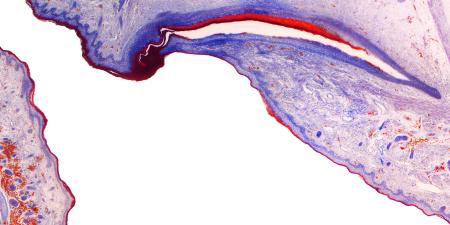Case
After finishing the first 3 years of medical school, Sarah decided to take a year off to spend time in a basic science laboratory. The aspect of the lab that she liked most was the tremendous latitude and independence to devise, develop, and test her own project idea while still receiving the necessary support and guidance from her postdoctoral fellow and her primary investigator, Bill.
As the year-long experience began to draw to a close, Sarah began to spend more nights and weekends in the lab to finish the project before returning to her clinical duties. When she sent the first draft of the manuscript to Bill for review, she was pleased that he believed it to be nearly publication-ready, suggesting only a few minor changes. She was surprised, however, by one of his first comments: “Include Drs. Smith and Jones as coauthors—this is a topic of interest to them.” Drs. Smith and Jones were nationally known, well-regarded senior investigators in the department, but Sarah had never even met either of them.
Commentary
Why would Bill want Sarah to include Drs. Smith and Jones as coauthors? Clearly, their inclusion in the byline is honorary and not reflective of work on the research project or manuscript. Three reasons could be hypothesized [1, 2]. First, Bill might hope that having the names of these researchers attached to the paper will garner better reviews of it. We know that they are interested in the field and are nationally known, so perhaps Bill anticipates the paper’s peer reviewers will recognize their names on the byline and think favorably of the paper, irrespective of its content. Second, Bill may be wishing for some sort of quid pro quo —either returning a favor from Drs. Smith and Jones or hoping they will include him on their papers or pay him back in some way. Third, Bill may be obligated to include them because they are senior investigators. It may be a departmental expectation that Drs. Smith and Jones be listed as authors because of their positions of authority (e.g., division or department chair). Or there could be covert pressure or coercion on Bill by Drs. Smith or Jones to be included on the paper.
Why should Sarah care? If she were purely self-interested, she would think that including the doctors as coauthors would add prestige to the paper and increase its chance of being published. She wants the paper to be published so she can gain recognition for her work and add the publication to her CV. If she asks other medical students or perhaps the postdoctoral fellow in her lab, they may tell her that this is a common practice and that she should not rock the boat.
According to medical literature, the assertion of Sarah’s colleagues appears, in fact, to be true. As far back as 1982, it was recognized that the scientific literature contained many names on the byline of people who had fulfilled no real criteria for authorship [3]. Since then, several studies have examined the contributions of authors to multi-authored articles. A 1994 study of 10 leading biomedical journals again showed that a significant number of coauthors had made little to no substantive contributions to the reported research [4]. A study of BMJ articles over a 20-year period found not only an increase in the overall number of authors per article but also a higher percentage of professors and department chairs being listed as authors [5]. It can be speculated that their inclusion was more honorary than anything else. Eleven to 25 percent of articles in American journals, with large and small circulation, have included honorary authors [6]. Similar concerns have been found in Cochrane reviews; 39 percent of reviews published in 1999 had evidence of honorary authors [7].
A study of articles published in the American Journal of Roentgenology in the 1990s yielded interesting results [8]. First, as the number of coauthors increased, so did the percentage of undeserved authors, to as high as 30 percent. Second, nearly 40 percent of undeserved authorship was attributed to the first author’s feeling obliged to or fearful of the honorary coauthor. This was more likely to occur when the first author was a non-tenured staff member in a position of vulnerability relative to a senior author. Lastly, the most common reason cited was concern about academic promotion.
Should Sarah just accept the notion of honorary authorship as part of the price of “doing business” in academia? In an academic world ruled by the publish-or-perish paradigm, why not just spread the wealth and assign authorship to one’s colleagues, so they can get ahead too? The answer, of course, is that this practice would be unfair to those who actually have put in the work. If a name on a byline is the currency by which we value that individual’s contributions to scientific advancement, it would be wrong to give credit where credit is not due. Sarah’s answer lies in confronting the age-old conundrum in ethics called the “is, ought” problem. This commonly voiced ethical concern argues that merely identifying what is being done does not tell us what ought to be done. Just because Sarah learns that students in her situation do accept honorary authors on their publications does not entail that Sarah ought to do the same.
Several options are available to help Sarah determine what she ought to do. Journals have well-established guidelines about what counts toward authorship. Her institution may have student and faculty policies about proper scientific authorship. Perhaps most importantly, Sarah has a cogent ethical argument based in the core definition of science. She has taken a year off to learn how to be a researcher, and one of the key lessons in the research community is that a scientist must be true to science. The aim of scientific research is to seek the truth—to explain a phenomenon by following a rigorous methodology. When she publishes results of her research, she is affirming that they are accurate and have been generated as a consequence of the scientific method. Putting on a research paper the name of someone who has not been part of that process is neither accurate nor truthful.
Guidelines for Assigning Authorship
Sarah should set up a meeting with Bill to discuss her concerns about including Drs. Smith and Jones on the manuscript. She should appeal to the authorship guidelines, which have existed for over 30 years. The International Committee of Medical Journal Editors (ICMJE), originally known as the Vancouver Group, has established uniform requirements for authorship and other aspects of writing a manuscript for a biomedical journal. According to the ICMJE, two principles guide authorship decisions—contributorship and guarantorship [9].
The latter principle, guarantorship, mandates that each author agrees to take public responsibility for the content of the article. In Sarah’s case, Drs. Smith and Jones may agree to take public responsibility, but if they have not been part of the study, it may be difficult for them to speak to all aspects of the research project. The public responsibility cuts both ways, of course—if the paper is well-received, the authors can accept the accolades, but if problems are found in the manuscript or research project, they must be ready to accept criticism. Moreover, there have been instances of senior authors who did not even know they were listed in a byline, so Sarah may want to ask Bill if he has spoken to either doctor about the research. Have they even read the manuscript?
Irrespective of whether Drs. Smith and Jones are ready to serve as guarantors of the manuscript, Bill still has to address the principle of contributorship. Authors’ contributions to research articles have received a great deal of attention over the past decade. A study of authorship in The Lancet developed a taxonomy of the contributions by each author on the byline; the investigators found that 44 percent of contributors in the articles did not meet the ICJME guidelines [10]. Earlier, the same authors (Rennie et al.) proposed moving toward disclosure of each author’s specific contribution as a means of ensuring accountability [11]. While some commentators have suggested abandoning the concept of authorship altogether, academia still sees a role for assigning authorship, provided there is transparency in “who did what” [12]. Some journals have moved in the direction of disclosure of contributions to allow better acceptance of credit and responsibility by authors. This is not a failsafe mechanism, especially if it relies on self-reporting, but it is supported by the AMA Manual of Style [13-16].
According to the ICJME uniform requirements, “authorship credit should be based on: (1) substantial contributions to conception and design, acquisition of data, or analysis and interpretation of the data; (2) drafting the article or revising it critically for important intellectual content; and (3) final approval of the version to be published” [9]. Sarah should point out to Bill that Drs. Smith and Jones have not been involved in the study over the past year and therefore do not fulfill the first criterion. Perhaps some of this turmoil could have been avoided had a prior agreement been negotiated to clarify roles and plans for the paper, but this is Bill’s role [17]. As a student, Sarah is in a relatively vulnerable position, so Bill has a responsibility as her mentor to establish clear authorship guidelines for the research team.
Confronting Bill about this will not be easy. Sarah will need to use negotiating and conflict-resolution skills [18, 19]. Since she clearly has the guidelines on her side, she should not yield to pressure, only to principled arguments. As with any difficult conversation, it would be wise for her to understand Bill’s perspective [20]. Maybe he’s under pressure from Drs. Smith or Jones. Maybe there’s more to the story than he initially told Sarah. Learning this additional information does not mean that Sarah has to alter her position, but it can at least provide a path to a solution that is amicable and mutually advantageous.
Authorship determination in biomedical research is a combination of etiquette and ethics. Polite, respectful dialogue among colleagues can resolve many conflicts. When there are truly disputes about assigning proper credit, the concerns affect ethics. Justice, fairness, and truthfulness dictate that Sarah speak to Bill and question the inclusion of Drs. Smith and Jones as coauthors on the paper. The byline should include Sarah as first author, the postdoctoral fellow as second author, and Bill as last author.
References
-
Feeser VR, Simon JR. The ethical assignment of authorship in scientific publications: issues and guidelines. Acad Emerg Med. 2008;(10):963-969.
- Claxton LD. Scientific authorship. Part 2. History, recurring issues, practices, and guidelines. Mutat Res. 2005;589(1):31-45.
- Burman KD. “Hanging from the masthead”: reflections on authorship. Ann Intern Med. 1982;97(4):602-605.
- Shapiro DW, Wenger NS, Shapiro MF. The contributions of authors to multiauthored biomedical research papers. JAMA. 1994;271(6):438-442.
- Drenth JP. Multiple authorship: the contribution of senior authors. JAMA. 1998;280(3):219-221.
- Flanagin A, Carey LA, Fontanarosa PB, et al. Prevalence of articles with honorary authors and ghost authors in peer-reviewed medical journals. JAMA. 1998;280(3):222-224.
- Mowatt G, Shirran L, Grimshaw JM, et al. Prevalence of honorary and ghost authorship in Cochrane reviews. JAMA. 2002;287(21):2769-2771.
- Slone RM. Coauthors’ contributions to major papers published in the AJR: frequency of undeserved coauthorship. AJR Am J Roentgenol. 1996;167(3):571-579.
-
International Committee of Medical Journal Editors. Uniform requirements for manuscripts submitted to biomedical journals: writing and editing for biomedical publication. 2008. http://www.icmje.org. Accessed March 3, 2009.
- Yank V, Rennie D. Disclosure of researcher contributions: a study of original research articles in The Lancet. Ann Intern Med. 1999;130(8):661-670.
- Rennie D, Yank V, Emanuel L. When authorship fails. A proposal to make contributors accountable. JAMA. 1997;278(7):579-585.
-
Smith R. Authorship: time for a paradigm shift? BMJ. 1997;314(7086):992.
- Bates T, Anic A, Marusic M, Marusic A. Authorship criteria and disclosure of contributions: comparison of 3 general medical journals with different author contribution forms. JAMA. 2004;292(1):86-88.
- Ilakovac V, Fister K, Marusic M, Marusic A. Reliability of disclosure forms of authors’ contributions. CMAJ. 2007;176(1):41-46.
- Marusic A, Bates T, Anic A, Marusic M. How the structure of contribution disclosure statements affects validity of authorship: a randomized study in a general medical journal. Curr Med Res Opin. 2006;22(6):1035-1044.
- Christiansen SL. Ethical and legal guidance in biomedical publishing: the AMA manual of style. 10th ed. Chest. 2008;134(6):1344-1346.
- Newman A, Jones R. Authorship of research papers: ethical and professional issues for short-term researchers. J Med Ethics. 2006;32(7):420-423.
-
Fisher R, Ury W, Patton B. Getting to Yes: Negotiating Agreement Without Giving In. 2nd ed. New York, NY: Penguin Books; 1991.
-
Thomas KW, Thomas GF. Introduction to Conflict and Teams: Enhancing Team Performance Using the TKI. Palo Alto, CA: CCP; 2004.
-
Stone D, Patton B, Heen S. Difficult Conversations: How to Discuss What Matters Most. New York, NY: Viking Press; 1999.



